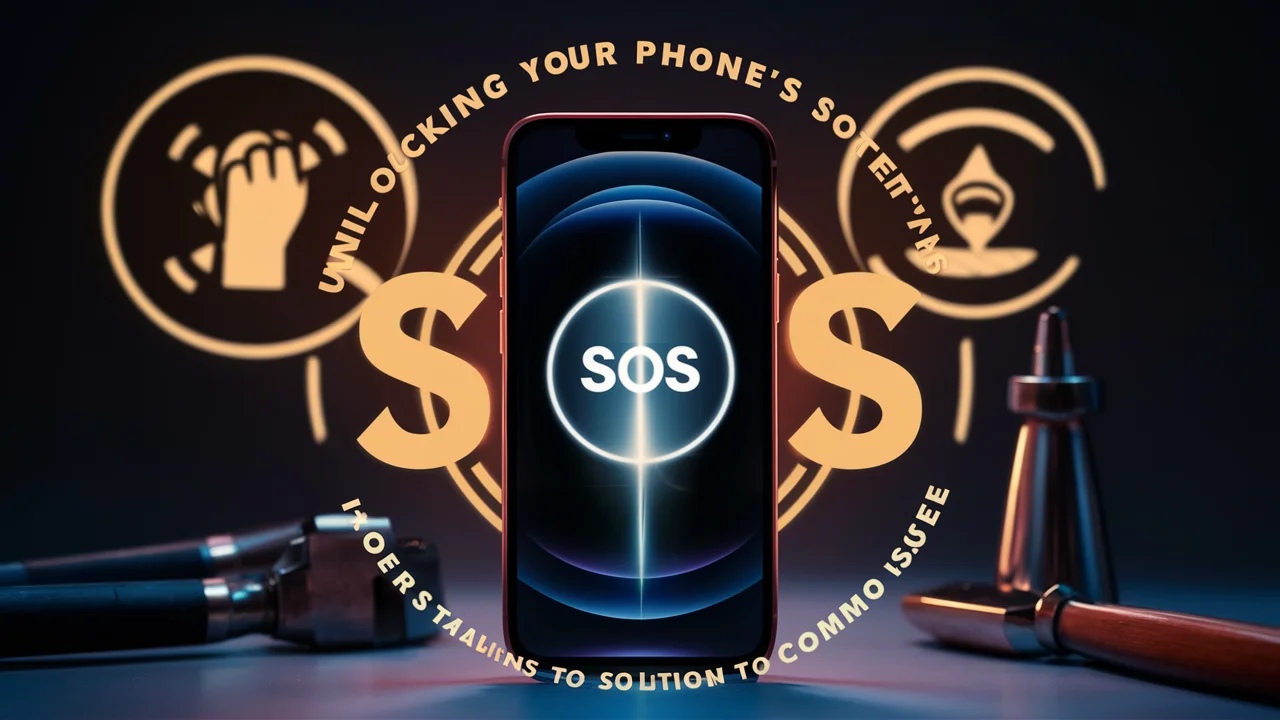Seeing “SOS only” on your phone can be frustrating, especially when you need to stay connected. This issue often leaves you wondering why your phone is stuck in this mode and how to fix it quickly. Don’t worry; you’re not alone in facing this problem, and this guide is here to help.
- What does “SOS only” mean? It typically indicates that your phone can only make emergency calls because it’s not connected to your carrier’s network. This can happen for several reasons, from simple network issues to problems with your SIM card or phone settings. Understanding these causes is the first step to getting your phone back to normal.
- Why is this guide useful? We’ll break down the most common reasons your phone might display “SOS only” and offer step-by-step solutions that are easy to follow. Whether you’re using an iPhone or Android, this guide will provide practical advice for troubleshooting the issue.
- Who is this for? If you’ve seen “SOS only” on your phone and need a fast, effective fix, this article is for you. By the end, you’ll know exactly what to do to resolve the problem and prevent it from happening again.
With these solutions in hand, you’ll be able to get your phone working properly and stay connected whenever you need to.
What Does “SOS Only” Mean?

When your phone displays “SOS only,” it can be confusing and frustrating. This message indicates that your phone is only able to connect to emergency services, like 911, because it isn’t connected to your regular cellular network. Understanding what this means is key to resolving the issue.
- Emergency Calls Only:
The “SOS only” message typically means your phone has lost its connection to your carrier’s network but can still access any available network for emergency calls. This mode is a safety feature designed to ensure you can reach emergency services even if you’re outside your normal coverage area. Your phone is saying it can’t connect to your regular network but can still reach out in emergencies. - Why Does It Appear?
There are several reasons why your phone might show “SOS only.” A common cause is poor signal strength or being in a location with no coverage from your network provider. Other potential issues include network outages, problems with your SIM card, or account-related restrictions. For example, if your carrier’s network is temporarily down or your SIM card is damaged, your phone may switch to “SOS only” mode. - Impact on Your Phone:
When your phone is in “SOS only” mode, you can’t make regular calls, send texts, or use mobile data. You’re limited to emergency calls, which can be a big problem if you rely on your phone for work or to stay connected with family and friends. This makes it crucial to fix the issue as soon as possible. By understanding why this happens and knowing how to troubleshoot it, you can avoid the inconvenience and ensure your phone is always ready when you need it.
In the next section, we’ll explore the common causes of “SOS only” mode in more detail, so you can identify what might be causing the issue on your phone. This will help you take the right steps to fix the problem quickly.
Common Causes of “SOS Only” Mode
Understanding why your phone says “SOS only” is the first step to fixing it. This issue can arise from several different causes, each of which might require a different approach to resolve. Let’s explore the most common reasons your phone might display this message.
- Network Issues
1. Poor Signal or No Coverage:
One of the most frequent reasons for “SOS only” mode is poor signal strength or no network coverage. If you’re in a remote area, deep inside a building, or in an underground location, your phone might struggle to connect to your carrier’s network. When this happens, your phone defaults to “SOS only,” allowing you to make emergency calls even without a full connection. To resolve this, try moving to an area with better coverage or wait until you’re in a location with a stronger signal.
2. Network Outages:
Sometimes, your phone might show “SOS only” because of a temporary network outage. This can occur when your carrier is performing maintenance or experiencing technical difficulties. In such cases, your phone can’t connect to the network, and the “SOS only” message appears. Typically, these outages are short-lived, and your connection will return once the network is restored. You can check with your carrier or online to see if there’s an ongoing outage in your area. - SIM Card Problems
1. Misalignment or Damage:
Your SIM card plays a crucial role in connecting your phone to your carrier’s network. If your SIM card is misaligned, dirty, or damaged, it may cause your phone to lose its connection, resulting in “SOS only” mode. To fix this, carefully remove the SIM card, inspect it for any damage, clean it if necessary, and reinsert it properly. If the card is damaged, you might need to replace it.
2. Incorrect SIM Settings:
Sometimes, the issue isn’t with the physical SIM card but with the settings related to it. If your phone’s SIM settings are incorrect or if the SIM card needs an update, this could cause connectivity issues. You might need to manually adjust the settings or contact your carrier to ensure everything is configured correctly. - Account-Related Issues
1. Billing Problems:
Another common cause of “SOS only” mode is account-related issues, such as unpaid bills or service suspensions. If your account is not in good standing with your carrier, they may limit your service, which can result in your phone displaying “SOS only.” To resolve this, check your account status with your carrier and ensure all bills are paid and up-to-date.
2. Carrier Restrictions:
Sometimes, your carrier may impose restrictions on your account, especially if you’re traveling internationally and haven’t enabled roaming. This could lead to your phone showing “SOS only” because it can’t connect to the network abroad. To fix this, you may need to contact your carrier to lift any restrictions or adjust your plan to include international roaming. - Software Glitches and Bugs
1. Outdated Software:
Keeping your phone’s software up to date is essential for smooth operation. If your phone’s software is outdated, it might cause connectivity issues, including “SOS only” mode. Make sure your phone’s operating system is up to date by checking for any available software updates and installing them.
2. Software Conflicts:
Sometimes, certain apps or settings can conflict with your phone’s ability to connect to the network. These conflicts might trigger “SOS only” mode. If you’ve recently installed a new app or changed a setting, this could be the cause. Try uninstalling the app or reverting the setting to see if the issue is resolved.
Understanding these common causes can help you identify why your phone is stuck in “SOS only” mode and guide you toward the right solution. In the next section, we’ll go through detailed steps to fix this issue and get your phone back to normal.
Step-by-Step Solutions to Fix “SOS Only” Mode

Now that you understand the common causes of “SOS only” mode, it’s time to dive into the solutions. These step-by-step fixes will help you troubleshoot and resolve the issue, whether it’s a simple network problem or a more complex SIM card or software issue.
- Basic Troubleshooting
1. Check Signal Strength:
Start by checking your phone’s signal strength. If you’re in an area with weak or no coverage, move to a different location where the signal is stronger. Sometimes, a simple change in location can resolve the “SOS only” issue.
2. Toggle Airplane Mode:
Turning airplane mode on and off is an easy way to reset your phone’s network connection. To do this, swipe down from the top of your screen (on most phones) to access the quick settings menu, then tap the airplane mode icon. Wait a few seconds, then tap it again to turn airplane mode off. This forces your phone to reconnect to the network, which can often resolve the “SOS only” problem.
3. Restart Your Phone:
A quick restart can solve many minor software glitches, including “SOS only” mode. To restart your phone, hold down the power button until you see the option to restart. After restarting, check if the problem is resolved. This simple step can clear up temporary issues that might be preventing your phone from connecting to the network.
4. Remove and Reinsert SIM Card:
Sometimes, your SIM card may not be properly seated, causing connection issues. Carefully remove the SIM card from your phone, clean it gently with a soft, dry cloth, and then reinsert it, making sure it’s properly aligned. After reinserting, check if the “SOS only” message is gone.
5. Check for Software Updates:
Outdated software can cause connectivity issues. Go to your phone’s settings, look for the software update option, and install any available updates. Keeping your software up to date ensures that your phone has the latest features and bug fixes, which can prevent issues like “SOS only” mode. - Advanced Troubleshooting
1. Reset Network Settings:
If the basic steps don’t work, try resetting your phone’s network settings. This will erase all saved Wi-Fi networks, Bluetooth pairings, and other network-related settings, but it can often fix persistent “SOS only” issues. To do this, go to your phone’s settings, select “System” or “General,” then find the “Reset” option and choose “Reset Network Settings.” After resetting, reconnect to your networks and see if the issue is resolved.
2. Verify Carrier Settings:
Your carrier settings may need to be updated or reconfigured. Sometimes, these settings can become outdated or corrupted, leading to “SOS only” mode. To update them, go to your phone’s settings and look for a “Carrier Settings” or “Network” option. If an update is available, you’ll see a prompt to install it. Updating these settings can resolve issues related to your carrier’s network.
3. Test SIM Card in Another Phone:
To rule out a problem with your phone’s hardware, try inserting your SIM card into another phone. If the other phone also shows “SOS only,” the issue is likely with the SIM card itself or your account with the carrier. However, if the other phone connects normally, the problem might be with your original phone, which may need further inspection or repair.
4. Contact Your Carrier:
If none of the above steps work, it’s time to contact your carrier. They can check if there’s an issue with your account, such as unpaid bills or service suspensions, or if there’s a network problem in your area. Your carrier can also provide guidance specific to your phone model and network, helping you resolve the issue.
5. Factory Reset (Last Resort):
As a last resort, you can perform a factory reset on your phone. This will erase all data on your device and return it to its original settings, so be sure to back up your important data first. A factory reset can resolve any persistent software issues that might be causing “SOS only” mode. To do this, go to your phone’s settings, select “System” or “General,” then choose “Reset” and select “Factory Reset.” Follow the on-screen instructions to complete the process.
These solutions should help you resolve the “SOS only” issue and restore your phone’s normal functionality. By following these steps, you can ensure your phone stays connected and ready for use whenever you need it. Next, we’ll cover preventive measures to help avoid this problem in the future.
Preventive Measures to Avoid “SOS Only” Mode

Preventing your phone from getting stuck in “SOS only” mode in the future is just as important as knowing how to fix it. By taking a few simple steps, you can reduce the chances of this issue occurring again and keep your phone connected to your network at all times.
- Keep Your Software Updated
1. Regular Updates:
Always keep your phone’s operating system up to date. Regular software updates often include bug fixes and improvements that enhance your phone’s performance, including its ability to stay connected to your carrier’s network. To ensure you don’t miss any updates, enable automatic updates in your phone’s settings or regularly check for new updates manually.
2. Update Carrier Settings:
Carrier settings updates are crucial for maintaining a stable connection to your network. These updates optimize your phone’s network capabilities, ensuring it can connect to your carrier’s signal without issues. Whenever you receive a notification about a carrier settings update, install it promptly to prevent connectivity problems like “SOS only” mode. - Maintain Your SIM Card and Phone
1. Regularly Check Your SIM Card:
Periodically remove and inspect your SIM card for any signs of wear or damage. A damaged SIM card can cause connection issues, so if you notice any problems, consider replacing it with a new one. Additionally, make sure the SIM card is properly seated in its slot to avoid any disconnection from the network.
2. Protect Your Phone:
Physical damage to your phone can lead to various issues, including problems with network connectivity. Protect your phone with a sturdy case, and avoid exposing it to extreme temperatures or moisture. Taking good care of your phone can help prevent hardware-related issues that might cause “SOS only” mode. - Optimize Network Settings
1. Manage Network Preferences:
Adjust your phone’s network settings to optimize connectivity. For example, if you’re in an area with poor 4G or 5G coverage, switching to a 3G network might provide a more stable connection. You can do this in your phone’s network settings by selecting the appropriate network mode. This can help prevent your phone from switching to “SOS only” mode due to weak signals.
2. Enable Roaming if Traveling:
If you’re traveling internationally, make sure to enable roaming in your phone’s settings. Roaming allows your phone to connect to networks outside your carrier’s usual coverage area, preventing it from falling into “SOS only” mode. Check with your carrier about roaming charges and ensure your plan includes international roaming if necessary. - Monitor Your Account and Payments
1. Keep Your Account in Good Standing:
Ensure that your carrier account is up to date with payments and that there are no issues that could lead to service disruptions. Unpaid bills or other account-related problems can cause your carrier to limit your service, leading to “SOS only” mode. Set up automatic payments or reminders to keep your account current.
2. Review Your Plan:
Regularly review your mobile plan to ensure it meets your needs. If you often find yourself in areas with limited coverage, consider upgrading to a plan that offers better network access or roaming options. By choosing the right plan, you can avoid unexpected connectivity issues. - Stay Informed About Network Issues
1. Use Network Status Apps:
There are various apps available that can provide real-time information about network outages or coverage issues in your area. These apps can alert you to potential problems before they affect your phone, allowing you to take action, such as moving to a different location or switching to Wi-Fi calling.
2. Stay Updated on Carrier Notifications:
Pay attention to any notifications from your carrier regarding network maintenance or outages. Being aware of scheduled maintenance or temporary outages can help you plan accordingly and avoid being caught off guard by “SOS only” mode.
By following these preventive measures, you can greatly reduce the chances of encountering “SOS only” mode on your phone. Maintaining your phone, keeping your software and carrier settings updated, and staying informed about your network can help ensure that your phone stays connected and ready for use whenever you need it. In the final section, we’ll summarize the key points and provide some final tips for staying connected.
Summary and Final Tips for Staying Connected
Dealing with your phone showing “SOS only” can be frustrating, but with the right knowledge and steps, you can fix it and prevent it from happening again. Let’s quickly recap what we’ve covered and leave you with some final tips to keep your phone connected.
- Understanding “SOS Only” Mode
When your phone says “SOS only,” it means it can’t connect to your regular network and can only make emergency calls. This can happen due to various reasons like poor signal, network outages, SIM card issues, or even problems with your account or phone settings. - Common Causes and Fixes
We explored the most common causes, such as weak signals, network problems, SIM card misalignment, and software glitches. Basic troubleshooting steps like restarting your phone, toggling airplane mode, or checking your SIM card can often resolve these issues. For more persistent problems, resetting network settings or contacting your carrier might be necessary. - Preventive Measures
To avoid “SOS only” mode in the future, keep your phone’s software and carrier settings updated, maintain your SIM card, and protect your phone from physical damage. Additionally, staying on top of your carrier account and payments, optimizing network settings, and staying informed about network issues can all help keep your phone connected.
Final Tips
- Stay Calm and Act Quickly:
If you see “SOS only” on your phone, don’t panic. Start with the basic troubleshooting steps we discussed, and work your way through the more advanced solutions if necessary. - Keep Your Phone Updated:
Regularly check for software and carrier settings updates. These updates often contain fixes for connectivity issues, helping you avoid “SOS only” mode. - Monitor Your Coverage:
Be mindful of areas where your signal is weak or where there might be network outages. Use apps or your carrier’s tools to monitor network status and plan accordingly. - Reach Out for Help:
If you’ve tried everything and your phone is still stuck in “SOS only” mode, don’t hesitate to contact your carrier for assistance. They can provide support specific to your situation and help you get back online.
By understanding the causes, taking preventive measures, and knowing how to troubleshoot effectively, you can keep your phone connected and ready for use whenever you need it. Remember, staying proactive and informed is key to avoiding the inconvenience of “SOS only” mode.
FAQs About “SOS Only” Mode
To wrap things up, here are some frequently asked questions (FAQs) about “SOS only” mode that can help clarify any lingering doubts or concerns. These quick answers will provide additional insights into this common issue and guide you in troubleshooting and preventing it.
1. Why does my phone show “SOS only” when I have full bars?
Even if your phone shows full bars, it might still display “SOS only” if there’s an issue with your carrier’s network or your SIM card. The bars indicate signal strength, but if your phone isn’t connected to your carrier’s network for some reason—like a network outage or a problem with your account—it might default to emergency calls only.
2. Can I fix “SOS only” mode without contacting my carrier?
Yes, many “SOS only” issues can be resolved without contacting your carrier. Start with basic troubleshooting steps like toggling airplane mode, restarting your phone, or removing and reinserting your SIM card. If these steps don’t work, resetting your network settings or checking for software updates might help.
3. Will factory resetting my phone always fix “SOS only” mode?
A factory reset should be a last resort because it erases all data on your phone. It can fix persistent software issues causing “SOS only” mode, but if the problem is related to your SIM card, network, or carrier account, a factory reset might not solve it. Ensure you’ve tried all other troubleshooting steps first.
4. Is “SOS only” mode a hardware issue?
Not necessarily. While “SOS only” mode can sometimes result from hardware issues, such as a damaged SIM card slot or antenna, it’s more commonly caused by software glitches, network issues, or SIM card problems. You can rule out a hardware problem by testing your SIM card in another phone or using a different SIM card in your phone.
5. How can I prevent “SOS only” mode when traveling abroad?
When traveling internationally, make sure to enable roaming in your phone’s settings and check that your mobile plan includes international coverage. This will help your phone connect to local networks abroad, reducing the likelihood of it going into “SOS only” mode. Also, consider purchasing a local SIM card if you’re staying in a foreign country for an extended period.
6. Can using a VPN cause “SOS only” mode?
Using a VPN (Virtual Private Network) doesn’t directly cause “SOS only” mode, but it can sometimes interfere with your network connection, especially if the VPN is configured incorrectly. If you suspect the VPN might be causing issues, try disabling it and see if your phone reconnects to your carrier’s network.
7. Does “SOS only” mode affect my Wi-Fi connection?
No, “SOS only” mode only affects your cellular connection. Your phone should still be able to connect to Wi-Fi networks, allowing you to use the internet, make Wi-Fi calls, and send messages over Wi-Fi. If you’re having trouble with both cellular and Wi-Fi connections, there might be a broader issue with your phone’s network settings.
8. What should I do if “SOS only” mode happens frequently?
If your phone frequently goes into “SOS only” mode, it might indicate a recurring issue with your network, SIM card, or phone settings. Try the preventive measures we discussed, like keeping your software updated, maintaining your SIM card, and ensuring your account is in good standing. If the problem persists, consider contacting your carrier for further investigation.
9. Can a SIM card from another carrier fix “SOS only” mode?
If your phone is unlocked and you have access to a SIM card from another carrier, you can test it to see if the “SOS only” issue is related to your current carrier. If the new SIM card works and connects to the network, the issue might be with your original carrier’s network or your account. This can help you narrow down the cause of the problem.
10. Should I be concerned about my phone’s security if it shows “SOS only”?
“SOS only” mode itself doesn’t indicate a security issue, but it does mean your phone isn’t connected to your regular network. Ensure your phone is updated with the latest security patches, and be cautious about using public Wi-Fi networks while in this mode. If you suspect a deeper problem, such as malware or unauthorized access, consider running a security scan or contacting a professional.
By addressing these FAQs, you should now have a comprehensive understanding of “SOS only” mode, including how to troubleshoot, fix, and prevent it. Stay proactive in maintaining your phone’s health to ensure you remain connected whenever you need it.

I’m Dariel Campbell, the guy who loves making things look awesome at “Sublimes Print.” Playing with colors and designs is my thing. At Sublimes Print, we’re here to make your prints stand out and shine. Let’s make your ideas come alive on paper—come and join the fun at Sublimes Print!













